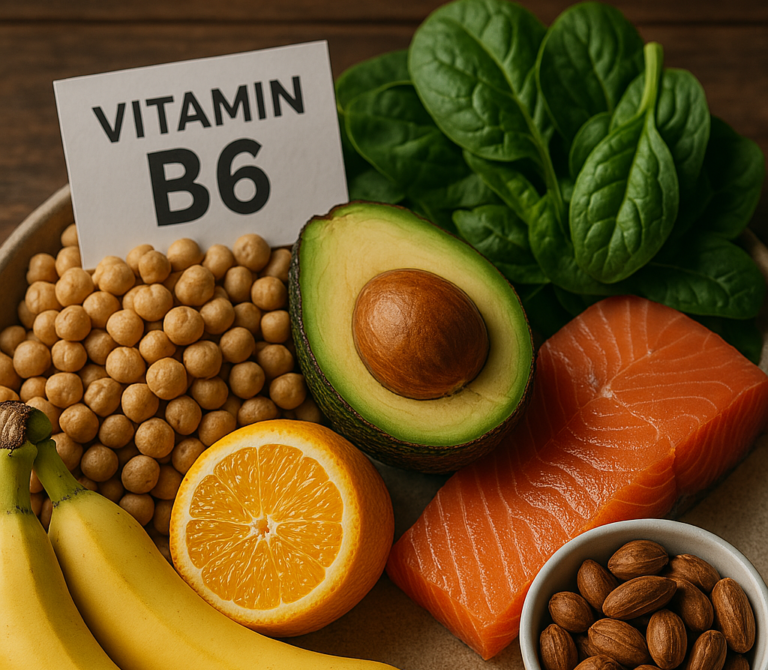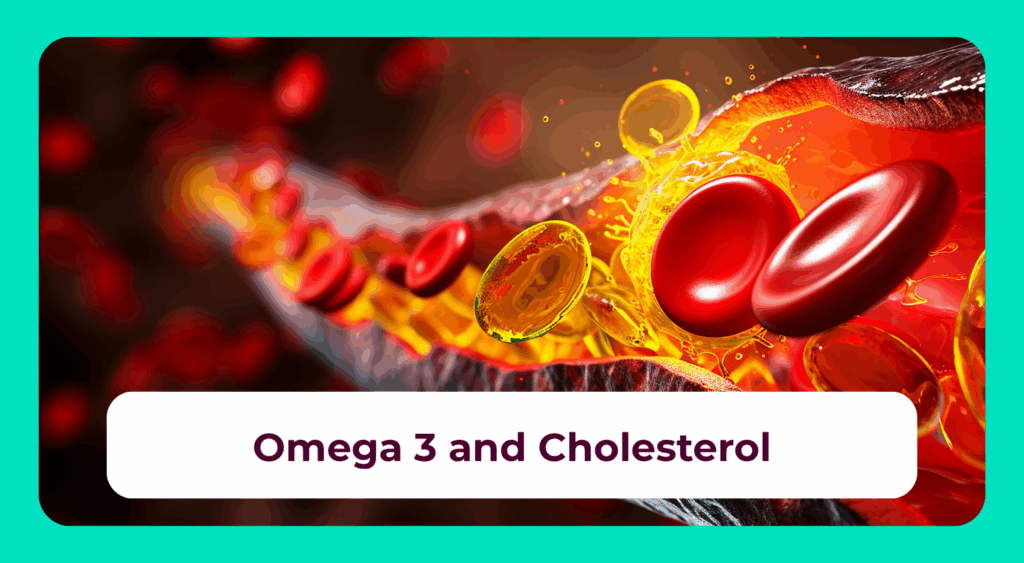Vitamin B6 ist ein wasserlösliches Vitamin. Da der Körper es nicht selbst bilden kann, ist die regelmäßige Zufuhr mit der Ernährung wichtig. Ein Mangel kann ernste Folgen für die Gesundheit haben. Gesunde Menschen können ihren Vitamin-B6-Bedarf mit den richtigen Lebensmitteln problemlos decken. Die zusätzliche Einnahme als Nahrungsergänzungsmittel ist in bestimmten Situationen dennoch sinnvoll.
Vitamin B6 in foods at a glance
Vitamin B6 is found in a wide range of animal- and plant-based foods.
Foods especially rich in pyridoxine include beef liver, soya beans, sesame seeds and salmon.
Most people can meet their vitamin B6 needs with a balanced diet.
If intake is limited to normal foods, an overdose is virtually impossible.
A deficiency may make it necessary to take a vitamin B6 supplement.
Why is vitamin B6 important?
Vitamin B6, also known as pyridoxine, has several functions in the body. The essential nutrient plays a role in metabolism, the immune system and the production of red blood cells.
It also contributes to:
normal nervous system function,
normal psychological function, and
hormone regulation.
What are the signs of a vitamin B6 deficiency?
If the body is not supplied with enough vitamin B6 over time, it can lead to anaemia and nerve function disorders. Deficiency can manifest through various symptoms.
Possible signs include:
inflammation in the mouth
facial rash
frequent infections
digestive issues
fatigue
irritability
confusion
Causes and treatment of a vitamin B6 deficiency
A vitamin B6 deficiency can have a number of causes. In addition to undernutrition, certain illnesses and some medications increase the risk. In most cases, a deficiency can be corrected with an appropriately dosed vitamin B6 supplement. Depending on the cause, further measures may be needed to treat an underlying condition.
What is the daily requirement for vitamin B6?
How much vitamin B6 you need depends mainly on your age and sex.
- According to reference values from the German Nutrition Society (DGE), adults require between 1.4 and 1.6 milligrams per day.
- Women typically need less than men, but their requirement rises to as much as 1.8 milligrams during pregnancy and breastfeeding.¹
Which foods contain the most vitamin B6?
Vitamin B6 is present in both plant- and animal-based foods.
- Among animal products, beef liver, fish and seafood such as sardines, salmon and lobster are especially rich in B6.
- Top plant-based sources include soya beans, walnuts, sunflower seeds and sesame seeds.

Which fruits and vegetables contain vitamin B6?
Almost all fruit and veg contain some vitamin B6. Although amounts are often small, bananas, broccoli, carrots and Brussels sprouts are excellent sources of this important vitamin.
Do oats contain a lot of B6?
Oats are known for their rich nutrient content. However, their B6 content is relatively modest at 0.16 milligrams per 100 grams. That said, they’re still a valuable part of a balanced diet.
Table of selected vitamin B6-rich foods (mg per 100 g)
Dairy products aren’t particularly rich in B6. For example, 100 ml of whole milk contains only around 0.05 milligrams. Some cheeses contain slightly more, but they do not contribute significantly to your daily intake.
Tabelle mit ausgewählten Vitamin-B6-reichen Lebensmitteln (mg pro 100 g)
Der B6-Gehalt von Milchprodukten ist nicht besonders hoch. 100 Milliliter Vollmilch bringen es beispielsweise gerade einmal auf 0,05 Milligramm. Manche Käsesorten enthalten zwar etwas mehr. Zu einer ausreichenden Versorgung tragen sie jedoch nicht nennenswert bei.
Meat and fish (mg per 100 g)
| Food | Vitamin B6 (mg) |
| Lobster | 1,18 |
| Salmon | 0.98 |
| Sardines | 0.97 |
| Beef liver | 0.96 |
| Mackerel | 0.63 |
| Goose | 0.58 |
| Chicken | 0.5 |
| Beef | 0.5 |
Fruit and vegetables (mg per 100 g)
| Food | Vitamin B6 (mg) |
| Bananas | 0.37 |
| Carrots | 0.3 |
| Brussels sprouts | 0.3 |
| Broccoli | 0.28 |
| Peppers | 0.27 |
| Lamb’s lettuce | 0.25 |
| Kale | 0.25 |
| Savoy cabbage | 0.2 |
Legumes and grains (mg per 100 g)
| Food | Vitamin B6 (mg) |
| Soya beans | 1.00 |
| Lentils | 0.6 |
| Chickpeas | 0.54 |
| Wheat bran | 0.73 |
| Peanuts | 0.44 |
| Brown rice | 0.28 |
| White beans | 0.41 |
| Oats | 0.16 |
Nuts and seeds (mg per 100 g)
| Food | Vitamin B6 (mg) |
| Walnuts | 0.87 |
| Sesame seeds | 0.79 |
| Sunflower seeds | 0.6 |
| Hazelnuts | 0.31 |
| Flaxseeds | 0.43 |
| Cashews | 0.25 |
| Brazil nuts | 0.24 |
How can you meet your vitamin B6 needs through diet?
With a balanced diet, it’s usually no problem to get enough vitamin B6. That also applies to vegans and vegetarians, who can draw on a wide variety of plant-based sources of pyridoxine.
Examples of meals that meet your daily requirement:
200 g of beef with 200 g of Brussels sprouts
100 g of salmon with 200 g of lamb’s lettuce
100 g of soya beans and two bananas
Want to Explore the Future of Nutrition?
Discover how genetic testing can provide in-depth insights into vitamin and mineral needs. Partnering with Novogenia opens the door to offering advanced, personalised health recommendations based on genetics. As an expert in nutrigenetics, Novogenia equips businesses with the tools to elevate their health services.
By becoming a Novogenia partner, you’ll gain access to cutting-edge genetic analyses, enabling you to offer your customers highly customised health solutions. With Novogenia’s support, businesses can stand out in the growing field of personalised nutrition, building customer loyalty and expanding service offerings. Take the next step in transforming health services and unlocking the full potential of nutrigenetics.
What should you keep in mind when storing and cooking food?
The vitamin B6 content of food can drop significantly during long storage. To minimise loss, store food in a dry, dark place and consume it soon after purchase. When cooking, use short and gentle methods to prevent the water-soluble vitamin from being destroyed by heat or leaching into the cooking water.
Can too much vitamin B6 cause side effects?
If you get your vitamin B6 from food alone, there is practically no risk of side effects from overconsumption. However, regularly taking high-dose B6 supplements can cause problems. In the long term, too much vitamin B6 may lead to nerve damage.
Possible symptoms of excess include:
numbness in arms and legs
muscle weakness
sensitivity to sunlight
paralysis
How can side effects be avoided?
o avoid side effects from excess intake, it’s important to follow recommended maximum daily doses.
- According to the European Food Safety Authority (EFSA), up to 12 milligrams per day is safe for healthy adults.²
- Germany’s Federal Institute for Risk Assessment (BfR) recommends a maximum of 0.9 milligrams per day from food supplements.³
Who needs a vitamin B6 supplement?
Gesunde Menschen können ausreichend Vitamin B6 aufnehmen, wenn sie sich ausgewogen ernähren. Obwohl laut der nationalen Verzehrsstudie II mehr als jeder zehnte Erwachsene seinen Tagesbedarf nicht erreicht, ist ein Nahrungsergänzungsmittel in vielen Fällen nicht notwendig.4 Bei Angehörigen einer Risikogruppe sieht das oft anders aus. Für sie kann der Griff zu einem Vitamin-B6-Präparat Sinn ergeben, um einen zusätzlichen Bedarf zu decken oder einen bereits bestehenden Mangel auszugleichen.
Important to know
If you are not a medical specialist and have complaints, specific health conditions, or suspect deficiencies, please make sure to consult a doctor to discuss this.
- 1 Deutsche Gesellschaft für Ernährung e.V.: Empfohlene Vitamin-B6-Zufuhr (Stand: 2019). URL: https://www.dge.de/wissenschaft/referenzwerte/vitamin-b6/ (zuletzt aufgerufen am: 24.09.2024).
- 2 European Food Safety Authority: Overview on Tolerable Upper Intake Levels as derived by the Scientific Committee on Food (SCF) and the EFSA Panel on Dietetic Products, Nutrition and Allergies (NDA) (Veröffentlichung: Juni 2024). URL: https://www.efsa.europa.eu/sites/default/files/2024-05/ul-summary-report.pdf (zuletzt aufgerufen am: 24.09.2024).
- 3 Bundesinstitut für Risikobewertung: Höchstmengenvorschläge für Vitamin B6 in Lebensmitteln inklusive Nahrungsergänzungsmitteln (Veröffentlichung: 22.02.2024). URL: https://www.bfr.bund.de/cm/343/aktualisierung-2024-hoechstmengenvorschlaege-fuer-vitamin-b6-in-lebensmitteln-inklusive-nahrungsergaenzungsmitteln.pdf (zuletzt aufgerufen am: 24.09.2024).
- 4 Max Rubner-Institut: Ergebnisbericht, Teil 2 Nationale Verzehrsstudie II (Veröffentlichung: 2008). URL: https://www.mri.bund.de/fileadmin/MRI/Institute/EV/NVSII_Abschlussbericht_Teil_2.pdf (zuletzt aufgerufen am: 24.09.2024).




